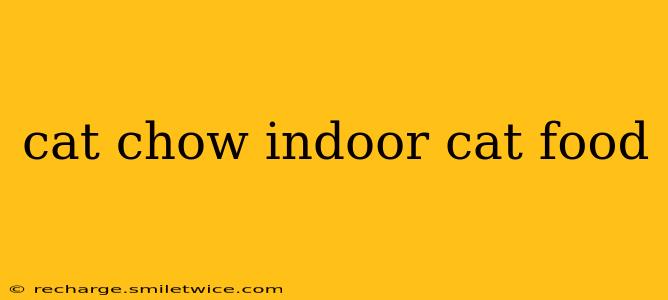Cat Chow Indoor is a popular cat food brand, but is it the right choice for your feline friend? This comprehensive review dives deep into the ingredients, benefits, drawbacks, and overall suitability of Cat Chow Indoor cat food, addressing common questions cat owners have. We'll explore whether it meets your cat's nutritional needs and how it stacks up against other options on the market.
What are the key ingredients in Cat Chow Indoor cat food?
Cat Chow Indoor formulations typically feature chicken, turkey, or fish as primary protein sources. The exact ingredient list varies depending on the specific formula (e.g., adult, kitten, etc.), but you'll generally find grains like corn, wheat, and soy, along with various fats, vitamins, and minerals. It's important to always check the specific ingredient list on the packaging as formulations can change. Looking for a high percentage of named meat sources at the beginning of the list is a good indicator of a higher quality protein source.
Is Cat Chow Indoor good for my cat?
Whether Cat Chow Indoor is "good" for your cat depends on their individual needs and your overall feeding strategy. For many cats, it provides a complete and balanced diet meeting basic nutritional requirements. However, it's crucial to understand that it's a mainstream, commercially available food, and thus may not be ideal for cats with specific dietary needs or sensitivities.
What are the benefits of feeding my cat Cat Chow Indoor?
- Affordability: Cat Chow is generally a budget-friendly option, making it accessible to a wide range of cat owners.
- Wide Availability: You can easily find it in most pet stores and supermarkets.
- Complete and Balanced Nutrition: It's formulated to meet the basic nutritional requirements of adult indoor cats, as defined by AAFCO (Association of American Feed Control Officials).
What are the drawbacks of feeding my cat Cat Chow Indoor?
- Ingredient Quality: Some cat owners prefer foods with higher-quality protein sources and fewer fillers (grains and by-products). The presence of grains can be a concern for cats with grain sensitivities.
- Nutritional Density: While meeting minimum requirements, it may not be as nutrient-dense as higher-end brands. This means your cat may need to eat more to obtain the same nutritional benefits.
- Potential for Allergies: The presence of common allergens like corn, wheat, and soy can trigger allergies in some cats.
What is the difference between Cat Chow Indoor and Cat Chow Complete?
While both are produced by Purina, the key difference lies in their target audience. Cat Chow Indoor is specifically formulated for the lifestyle of indoor cats, often incorporating ingredients and nutrient levels aimed at managing weight and promoting urinary tract health in less active felines. Cat Chow Complete is a broader formulation designed for a more active lifestyle and may have a different calorie count and ingredient profile. Always consult the product packaging for the specific details of each formula.
Does Cat Chow Indoor help with weight management?
Cat Chow Indoor formulations often have slightly lower calorie counts compared to other Cat Chow lines, making them more suitable for indoor cats who tend to be less active and prone to weight gain. However, weight management also depends on portion control and exercise (playtime!). Simply feeding a "weight management" food doesn't guarantee weight loss without proper management of caloric intake.
How much Cat Chow Indoor should I feed my cat?
The amount of Cat Chow Indoor you should feed your cat depends on their age, weight, activity level, and individual metabolic needs. Always follow the feeding guidelines printed on the package, which typically provide recommendations based on your cat's weight. Remember that these are just guidelines, and you may need to adjust the amount based on your cat's body condition. Consult your veterinarian if you're unsure about the appropriate feeding amount for your cat.
Is Cat Chow Indoor good for kittens?
Purina offers specific Cat Chow formulations designed for kittens, which differ from the adult indoor cat food. Kitten food contains higher levels of protein and calories to support their rapid growth. Using the adult formula for kittens would be inappropriate and could lead to nutritional deficiencies.
This review provides a balanced perspective on Cat Chow Indoor. While it offers an affordable and readily available option, discerning cat owners should weigh the pros and cons against their cat's specific needs and consider exploring higher-quality options if necessary. Always consult your veterinarian for personalized dietary advice for your cat.
